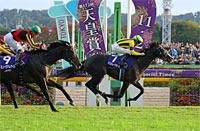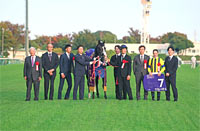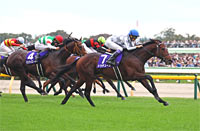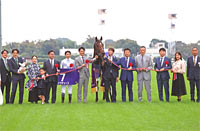Tenno Sho (Autumn) (G1) - Comments from runners' connections

Almond Eye
Sakae Kunieda, trainer
“This week, she trained as she did the week before, from about three lengths behind two other horses on the woodchip flat course and I asked Christophe Lemaire to check her responses in the finish. She looked very good. The difference in her weight didn’t show in the numbers but I think she’s looking sharper than she did before last week’s workout. The woodchip course can be rough on her legs, so I had her train on the dirt course on Oct. 25. After the Yasuda Kinen, she went to the farm just like last year. I haven’t seen any change in her due to age. I do feel that she is more laidback about things now and that is reflected in her condition a bit as well. Lemaire said her responses were good, her breathing too. In the Yasuda Kinen, the competition was strong and though she lost, I think she really gave it her best. She’s had a lot of time off but she has before and has always done well. She has come along fine so far and I would like to see her win her eighth Grade 1. My hopes are that the weather will be fine and that the race will go smoothly.” |
|

Blast Onepiece
Masahiro Otake, trainer
“He was slow from the gate in the Osaka Hai and the race didn’t pan out well for him. Then, in the Takarazuka Kinen it started raining right before the race and the surface wasn’t to his liking. After that race, he went off to the farm as usual. He looked tired so we took care to get him fully recovered. He came back to the training center on Oct. 8 looking refreshed and his preparation has gone well. He worked with another horse on the flat. On Oct. 22, the jockey rode. The woodchip course wasn’t in good condition so he didn’t feel that well in hand, but the jockey said he did respond well. The horse should be about close to 550 kg for the race. He has won on slightly heavy ground but has trouble if the grass is slippery from rain. A nice dry track is good. He has won over 2,000 meters, so I’m hoping he can get some good results at Tokyo.” |
|

Cadenas
Masaaki Shibata, assistant trainer
“Last out in the Mainichi Okan, he ran on the pace traveling much further forward than he normally would. His footwork was good in the stretch and he really tried hard over the slightly heavy track. It was a good solid race. There were no particular changes after that, and though he’s not a horse I’d normally race again so soon, he’s not tired, he’s on his toes, and it looks like he’ll go to the gate in good shape. Where to make his move this time is a difficult question. He’s good on a fast track, so I’d like for him to race where the ground is good. Since he’s moving from an 1,800-meter race to a 2,000-meter one, the distance isn’t a concern. I’m looking forward to seeing just how well he can do up against the Grade 1 winners.” |
|

Chrono Genesis
Yuichi Kitamura, jockey
“I think her performance in the Takarazuka Kinen was straightforward and strong. Compared to last year, I now see her improving with each race. Her weight has gone up and so has her power. I think the biggest difference now is that she much calmer, more laidback. She always got tense, but now in work she is calm and confident. Her fast work last week was good. She’s a very even-keeled filly so I’m happy when I do see improvement. Her mental maturity is reflected in her work now and overall she’s in good shape. This week the priority was to keep her from overdoing it and to keep her relaxed, and she did run nicely the whole way, so it was a good workout. She has kept up her strength all year. She does better with more time in between races. If they’re too close, she tenses up. I have no concerns about the Tokyo 2,000 meters. I don’t know if it exactly suits her but I don’t think she’s disadvantaged in any way. She’s versatile. As for the going, she can handle a dry track or a wet one. If it’s heavy, the others will have a hard time so that will be to her advantage.” |
|

Daiwa Cagney
Takanori Kikuzawa, trainer
“He tends to be a bit heavy coming off a layoff but since he’d been gelded he wasn’t as muscled up for the Mainichi Okan and he didn’t get too tense. He was limber and it worked in his favor. The winner was pretty far out in front but this one did a really good job up against some other good horses. Luckily, he came out of the race well and I was able to clock him in a solo workout on Oct. 22 already. He was relaxed and I think the race helped him let off some steam. He always has been one to improve with a race behind him, so I’m expecting to see that improvement on raceday. The lineup is strong, but he has gotten good results at Tokyo and being gelded should help him. Depending on how he breaks, he could lead. I just want him to run his own race and give it his all.” |
|

Danon Kingly
Keita Tosaki, jockey
“In his last start, the Yasuda Kinen, he broke well and raced nicely balanced, but in the final stage he didn’t extend like he usually does. There was nothing wrong with him in particular, but I did wonder a bit. I was just back from an injury and it was a great encouragement during my rehabilitation to get back in time to work with him. I rode him for his debut and at that time I felt he might be better suited to dirt but as he got older he got better and better and displayed an excellent turn of foot. He can basically run on any course but has won at Tokyo before, so I think the course makes it easy for him to race. I think he prefers a fast track and an inside gate is better than an outside one. The lineup is strong but I very much want him to win a Grade 1.” |
|

Danon Premium
Teruhiko Saruhashi, assistant trainer
“He spent the summer at the farm in Hokkaido and came back to the training center on Sep. 10. His training has all gone well and the time off did him good. He has been able to make a smooth transition into work. His mental preparation is perhaps the biggest part of his prep. We’ve tried all sorts of tack with him to see what works. I put blinkers on him for his fast work last week, then took them off on the weekend. I plan to decide right before the race which is better for him. He will wear a cross noseband. Last week his weight was 511 kg and I think his weight on raceday will be right about where it was for his last start. Last year, both here and in the Mile Championship afterward, he lost concentration at the end and seemed to just quit running. I think it was mostly mental. I’m trying to find out what will best help him get on his game more. If he would just give it a solid run to the very end, I think he has a chance.” |
|

Fierement
Takahisa Tezuka, trainer
“He worked alone in fast work this week and he did well. His movement was good. Last week, he worked in a trio and the ground was rough so I had him travel on the far outside. Yuichi Fukunaga rode him and pushed him pretty hard. So, this week working solo was good for him. I had instructed Fukunaga to get after him a bit when he got up to speed. And the jockey said he didn’t feel like a horse that ran a 3,000-meter race. Apparently he meant he was better suited to a shorter distance, so that’s a plus. I’d intended for him to start the fall with the Sankei Sho All Comers but the day before his final fast work he had a fever, so I decided against working him hard and had him withdrawn from the race. He only took one day off so I don’t think it had any impact. I sent him to the farm for a bit before starting his prep for here. I think his best weight is around 480 kg but he was nearly 490kg for the Tenno Sho (Spring). He’s looking his best right now. Tokyo is spacious and with its long stretch, it should be a good venue for him, one that allows him to move out powerfully.” |
|

Jinambo
Noriyuki Hori, trainer
“After his run in the Niigata Kinen I kept him at the training center to prepare him for his next race. When we decided on this race as our target, I decided that the focus of his preparations would aim at strengthening his lungs and getting him leaner. Up to this point, the priority had been getting him mentally ready to race so he was a bit thick around his belly and his breathing wasn’t the best but with the years he is more laidback and more balanced mentally and physically so he’s come along well. It’s a good season for training and from two weeks ago I upped the pitch. I think he’s improved quite a bit. Of course, the lineup is strong but a race with one turn and run to the left is best for him and the groundwork for him to do battle here has been laid.” |
|

Kiseki
Katsuhiko Sumii, trainer
“I had to think long and hard about just what his two prep races in the spring should be. When the distance is over 2,000 meters he clamps down on the bit, so I didn’t know whether it was best to send him forward from the gate or to hold back and keep something for the final stage. Yutaka Take held him back in the Takarazuka Kinen and got good results. Since taking time off in the summer he’s able to race better in hand than before. After the Takarazuka he went to the farm where he was born to refresh. Wanting to get an early start on his training I had him return to the training center early and he’s gotten plenty of work. Yutaka Take rode him on Oct. 21 to get a feel for him after his prep race. The ground on the hill course has been slow on many days recently but his times have still been good and Take said the horse felt good. There is always a concern about how well he’ll settle so I put another horse ahead of him to see how he’d respond. He was patient to the end. If the track is heavy, other horses will be disadvantaged, which is a plus for him.” |
|

Scarlet Color
Ryo Takahashi, trainer
“From the results, I’d say luck wasn’t on her side in the Queen Stakes. Still, she ran her own race and her footwork was good in the final stage. It was a solid race, nothing tragic. I’d taken her to Sapporo and raced in the hot summer so he had lost some condition, but the farm got her back looking good. Since returning to the training center, she’s worked her on the flat over distance and has run eagerly. She has improved overall. In other years, this race is often decided by the fastest final speed. A lot will depend on whether the surface suits her. I think a small field and the wide-open course is good for her. If the trip suits, we’ll see just how well she can do.” |
|

Win Bright
Yoshihiro Hatakeyama, trainer
“His plans to go from Dubai to Hong Kong this year were all cancelled, so after returning to Japan I switched our sights to the Takarazuka Kinen. At the farm, they found some hoof problems and it took a while for his hoof to grow out. It was all in all an unlucky start to the year. There are only so many races he can enter so this is where we decided to make his comeback. After returning to Miho, we upped the pace of his work quite a bit since he hadn’t gotten much work at the farm due to his hoof trouble and he had lost muscle. Jockey Masami Matsuoka rode him for fast work last week and he still looked like a horse coming back after a layoff. There was a lot of room for improvement, so we’ll just have to see how much better he can get by raceday. The most important thing is that he comes out of the race well and that this start will serve him well in his next one.” |
|
Sources: Keiba Book, Netkeiba
|

- Preview
- Barrier draw
- Past performances of runners

- News
- Race result
- Video
- 2025 English

- 2024 English

- 2023 English

- 2022 English

- 2021 English

- 2020 English

- 2019 English

- 2018 English

- 2017 English

- 2016 English

- 2015 English

- 2014 English

- 2013 English

- Photo Gallery
2025 Winner: Masquerade Ball


2024 Winner: Do Deuce


|





